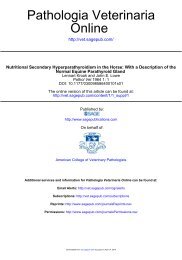Preventing Laminitis - Dr Jennifer Stewart
Preventing Laminitis - Dr Jennifer Stewart
Preventing Laminitis - Dr Jennifer Stewart
You also want an ePaper? Increase the reach of your titles
YUMPU automatically turns print PDFs into web optimized ePapers that Google loves.
<strong>Preventing</strong> laminitis in horses 97<br />
Table 1 Known or Presumed Factors that Can Cause or Contribute to the Development of <strong>Laminitis</strong> in Horses, Ponies, and Other<br />
Domestic Equids<br />
Causes Contributing Factors*<br />
unrestricted access to improved pastures during periods of<br />
high fructan content (eg, spring, fall, cold stress)<br />
grain overload (ingestion of large quantities of dietary starch)<br />
fiber carbohydrates (NFC), as distinct from the fibrous structural<br />
carbohydrates (cellulose, lignin, etc.) which give plants<br />
their structural integrity and support (ie, the plant’s skeleton).<br />
Nonstructural carbohydrates are produced by the plant<br />
during daylight hours (via the process of photosynthesis) and<br />
are used by the plant as an energy source for growth and<br />
reproduction. Any excess NSCs are stored in the leaves and<br />
stems for later use, and, once the plant flowers, in the seeds to<br />
history of laminitis (even if previous episode was mild)<br />
high-grain diet (>5 lb of grain-based feed for the average<br />
sized horse)<br />
severe intestinal disease (eg, “surgical” colic, enterocolitis) consumption of endophyte-infested tall fescue<br />
other serious systemic illness (eg, pleuropneumonia,<br />
overweight (BCS of 6 or greater); the greater the BCS, the<br />
Potomac horse fever)<br />
greater the laminitis risk<br />
endo/metritis secondary to retained placenta pony or Morgan<br />
untreated equine Cushing’s disease (older horses) inactivity<br />
severe hypovolemia (eg, severe dehydration, severe blood occasional strenuous exercise (“weekend warriors”)<br />
loss, toxemia)<br />
exercise at speed on a hard surface (“road founder”)<br />
sustained, nonweight-bearing lameness in one limb (ie, glucocorticoid administration (the higher the total dose,<br />
contralateral limb laminitis)<br />
the greater the risk)<br />
exposure to black walnut heartwood (usually as wood<br />
stress (eg, high-stress occupation or environment,<br />
shavings used for bedding)<br />
transportation, hospitalization?)<br />
small feet for the size or weight of the horse (usually<br />
linked to BCS >6)<br />
flat or thin soles, or excessive trimming of the wall or sole<br />
(ie, less-than-optimal protection for palmar/plantar<br />
digital vasculature)<br />
BCS body condition score (see Table 2).<br />
*These factors, while they may not cause laminitis on their own, appear to increase the risk for laminitis and may cause laminitis when two or<br />
more are present concurrently.<br />
lush pasture<br />
46%<br />
grain overload<br />
7%<br />
unknown<br />
15%<br />
colic or diarrhea<br />
3%<br />
other known<br />
27%<br />
retained placenta<br />
2%<br />
Figure 1 Causes of laminitis identified in a recent nationwide survey<br />
(from Lameness and <strong>Laminitis</strong> in U.S. Horses. USDA: APHIS: VS,<br />
CEAH, National Animal Health Monitoring System. USDA, 2000).<br />
“Other known” causes included feed problems and complications of<br />
injury, obesity, or pregnancy. Each comprised less than 2% of all<br />
cases, so these diverse factors were combined into one group for this<br />
chart.<br />
fuel germination and sustain the seedling until it can produce<br />
sufficient NSCs of its own.<br />
Grains such as oats, corn, barley, wheat, and millet—<br />
which actually are the seeds of grasses—are high in starch<br />
and simple sugars. Pasture grasses also are high in sugars at<br />
certain stages of their growth cycle and during times of environmental<br />
stress (eg, cold weather). These two feed sources,<br />
grain and grass, must therefore be fed with care in horses.<br />
The circumstances in which excess carbohydrate intake<br />
can lead to laminitis can be divided into two categories:<br />
1. carbohydrate overload—ie, a large meal that is high in<br />
starches or sugars (whether grain or grass)<br />
2. chronic overfeeding (usually coupled with relative inactivity),<br />
resulting in a horse that is overweight.<br />
Either circumstance increases a horse’s laminitis risk.<br />
When both are present, the horse’s risk for developing laminitis<br />
greatly increases, particularly when other triggers (eg,<br />
illness, injury, stress) occur. Following are some dietary strategies<br />
that, when consistently followed, can substantially decrease<br />
a horse’s laminitis risk.<br />
Pasture Management<br />
Access to lush pasture is the single most important risk factor<br />
for laminitis on farms where pasture is available for grazing.<br />
While pasture grasses contain a wide variety of structural and<br />
nonstructural carbohydrates, the ones that appear to be most<br />
important, with respect to laminitis risk, in many of the pasture<br />
grasses in the U.S. are called fructans. Fructans are NSCs<br />
that cannot be broken down by enzymes in the horse’s small<br />
intestine; they bypass digestion and absorption in the small<br />
intestine and reach the large intestine, where they are rapidly<br />
fermented by the resident microbes.



